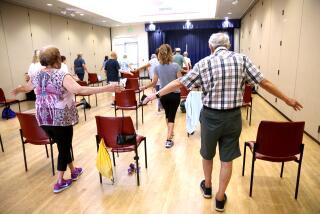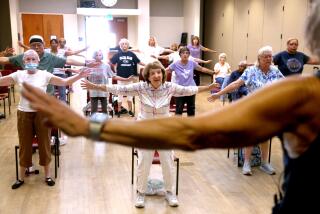Sort of like a StairMaster -- but for the brain
Ask anyone whoâs ever forgotten the name of a longtime co-worker, re-read a paragraph four times before absorbing its content, or hit the brakes too slowly to avert a fender-bender: When the mental strength and agility of youth start to slip, the wisdom of age tells you something.
You want it back.
If a method of preserving or restoring that youthful mental vigor were safe, inexpensive and as simple and diverting as playing a video game for a short while each day, wisdom would also tell you to do it.
That calculation is why mental fitness programs have become the latest frontier in the nationâs quest to age without conceding to infirmity.
The programs vary widely in format and cost, including online programs that cost $10 per month, hand-held games that can cost $140 and software packages priced at about $400. Special touch-screen consoles designed for a communityâs use or specialized programs for people with conditions such as attention deficit can cost several thousand dollars.
In the last three years, these brainpower-boosting programs have proliferated, with names like MindFit, Happy Neuron, Brain Fitness and Lumosity. Americans this year are expected to invest $225 million in these programs -- up from just $70 million in 2003 -- in an effort to tune up the brain, strengthen the memory and forestall or reverse the cognitive slippage that often comes with age, psychiatric disease, stroke or medical treatments.
But when an industry springs up so quickly, and makes claims so sweeping and seductive, the wisdom and experience of age should tell you one more thing: Ask for evidence and expect hype.
âThere is plausibility, both biological and behavioral, to the claim that these may work,â says Molly Wagster, chief of the National Institute on Agingâs neuropsychology branch. âBut it is still a situation of âbuyer beware.â â
Insurance companies such as Humana and Penn Treaty American Corp. have begun to distribute software programs such as Posit Scienceâs Brain Fitness 2.0 to millions of their older customers. In two years on the market, Nintendoâs Brain Age, a video game designed to be played on a hand-held game device, has sold 10 million copies worldwide. Retirement communities are rushing to establish brain gyms to help current residents sharpen their mental skills and to attract baby boomers, who may one day put such amenities on a par with a weight room and a track.
âI see this as a new frontier of fitness overall,â says Alvaro Fernandez, founder and chief executive of the website SharpBrains .com, which tracks the business and science of brain-training. Americans already understand the value of physical fitness as a means of preserving the bodyâs proper function and preventing age-related diseases, says Fernandez.
He predicts that cognitive fitness will become a goal to which Americans equally aspire as we learn more about aging and the brain.
--
In class or online
Kathy Kurschner, a 64-year-old Angelino now retired from a busy job in the travel industry, says she possessed âan incredible memoryâ until a few years ago, when little lapses -- not remembering the date, finding she could not hold on to the name and face of someone she had just met -- told her âit was not so wonderful anymore.â
When Kurschner saw a call for volunteers for a UCLA program now called Memory Bootcamp, she readily signed up. The five-week session taught strategies designed to strengthen and support short-term, or âworking,â memory and tune up attention skills. Organized by UCLA psychiatrist Dr. Gary Small, the program now is offered in several Los Angeles locations.
âI want to do as much as I can to keep my mind alert,â says Kurschner, who has gone on to teach some of the skills at the Center for Healthy Aging in Santa Monica. She believes that the program has strengthened her memory, in part by underscoring the role that attention, stress reduction and exercise play in keeping the mind sound.
Some of those seeking a mental recharge are surprisingly young. At 28, Lucas Mills has just entered Yale Law School after taking a year off to surf, explore the computer graphics industry and knock around Los Angeles.
âYou can notice differences in performance, especially when you go from college to the real world, where youâre not as stimulated every day,â said Lucas. âWith the specter of law school looming, I decided I had to do better.â
A friend introduced Lucas to an online cognitive exercise program called Lumosity, commercially launched this summer. Lumosity presents a wide range of exercises that target different mental processes that decline with age, including working memory, speed of processing and attention.
The program was designed to address the needs of the baby-boom-and-older demographic, and its makers have conducted small-scale clinical trials of its effectiveness on this group. But theyâve found since its launch that the program has gained a devoted audience of twenty- and thirtysomethings as well.
âIt was a nice little tuneup,â said Lucas, who enjoyed the lively graphics of Lumosityâs games, and the fact that its program allows a subscriber to track his improvement and advance to more challenging levels.
--
New thinking about brains
For decades, physicians and scientists asserted that declining mental performance is an immutable fact of aging. Brain cells inexorably are lost with age and wear-and-tear, they believed. And unlike most other organs capable of self-repair, lost brain cells cannot be replaced, they said.
But the past 15 years have brought about a revolution in thinking about the brain -- not only its ability to generate replacement cells but to respond at any age to a stimulating environment by strengthening and developing new connections between cells and among different regions of the brain.
The bulk of this evidence is based on experiments done on animals -- mostly rodents. But in recent years, human studies too have begun to link mental stimulation across the life span with better mental performance in old age -- an effect that appears powerful enough to delay the symptoms even of a devastating brain disease like Alzheimerâs. But is this neural âplasticityâ happening in humans? Do training programs effect changes in the human brain? Will someone who improves his or her performance on a formal brain fitness program see improvements in everyday function? The answers to these crucial questions remain unclear.
âThere is no consistent and compelling body of evidence at this timeâ that demonstrates the value of brain-fitness programs in humans, says Elkhonon Goldberg, a New York University School of Medicine neuroscientist who advises companies, organizations and individuals interested in adopting a cognitive training program. âBut this is not to suggest such evidence cannot be attained. Itâs just a matter of conducting appropriate studies.â
Goldberg, who provides scientific advice on the website www.Sharpbrains.com, says that as neuroscientists use imaging technologies to âseeâ the cellular changes that come with learning, he grows more confident that well-designed training programs can have discernible everyday effects in preserving or repairing the intellectual function of older adults.
âThis is shared hardwareâ thatâs being changed in the brain, âand to the extent you somehow enhance it, that will have wide-ranging effects,â Goldberg says. âIt provides a much more compelling raison dâetre for this whole business.â
--
The study of lasting effects
In the last 18 months, published studies have begun to provide the first rigorous evidence that some brain-training exercises may have lasting effects on people -- particularly the elderly -- who use them. A trial using Posit Scienceâs Brain Fitness program (and sponsored by the company) found that a group of subjects with an average age of 71 who went through the eight-week program showed marked improvements in memory overall compared with a group that had not received the training. Posit Scienceâs program -- a package of software costing about $450 -- currently targets one specific aspect of cognitive performance: how incoming sounds are understood and processed.
âWe donât believe that the way to fix memory is to get people to remember more things,â says neuroscientist Henry Mahncke, Posit Scienceâs chief scientific officer. The companyâs Brain Fitness program instead targets what Mahncke calls one of the âroot problemsâ of age-related memory lapses: that the brain begins to filter out distractions more poorly, and so takes note of incoming information -- whether street signs or the name of a new acquaintance -- more slowly and less clearly.
Less than a year ago, a six-city clinical trial of cognitive training for people older than 65 offered further evidence that brain training -- even when it occurs briefly and later in life -- can help people cope better. The study showed that, compared with subjects given no access to mental training sessions, those who attended 10 sessions designed to sharpen inductive reasoning were better able to manage the daily tasks of independent living five years later. And those who got training for memory and speed of mental processing did a little better than the untrained, especially when they got eight sessions of booster training at roughly one and three years after the initial training.
Mahncke of Posit Science says that if the notion of brain fitness is to take hold -- and the market is to grow -- companies will have to establish their scientific credibility by conducting clinical trials with their products. Working with USCâs Andrus Gerontology Center, Posit Science has just completed the recruitment of 524 subjects to participate in a trial of its Brain Fitness program in those older than 65.
âThis is a fast-moving field,â said Mahncke. And companies -- some with the participation of neuroscientists, some without -- are making sweeping claims that are âjust so much hot airâ until they have been demonstrated in well-run studies, he adds.
In the meantime, customers are paying their money and taking their chances, on the argument that some organized program of mental stimulation -- even imperfect -- is better than enduring the slippage of mental acuity without a fight.
--
Rechanneling the time
Bonnie Theis, a 65-year-old from St. Cloud, Minn., now spends roughly $10 per month on Happy Neuronâs cognitive fitness programs, after putting in âway too much time in front of the boob tubeâ following her recent retirement from library science. The Happy Neuron program, designed by French neuroscientists and widely used in Europe, âtakes itself very seriouslyâ but is fun to use and has coached her to improve in the areas in which her performance is weakest, said Theis. After spending some time with the program most days for a year, she feels her attention to details in her environment has sharpened, her memory has improved and her response time to cues like traffic signs seems faster. And that perceived improvement is all she needs to justify the expenditure of time and money in a program.
âHow much proof do you need to go see a movie? The expense is the same,â said Theis. âItâs $10 a month -- big whoopee deal. . . . And the time I spend on it would be time spent doing a hand-held Sudoku game or watching TV. Iâd prefer to be learning while being entertained.â
--







